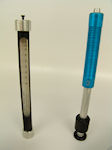This week in the laboratory you will
get hands-on experience with multiple indentation-type hardness tests.
Some hardness tests and
hardness testers are suitable for macro testing, while others
are intended for micro hardness measurements. The Brinell and
Rockwell tests are classified as macro hardness tests. The
objective of this week's experiment is to
determine the hardness of various metals and polymers using Rockwell,
Brinell and durometer tests.
The following are animated gifs showing elastic and plastic contact.
A soft photoelastic material was used for the elastic contact and Neutragena soap for the
plastic contact. (Jeff Thomas, Nov. 2004)
- not covered in IDE 110
- a quick, inexpensive, and
nondestructive materials testing technique
- used to give an indication of tensile
strength and the ability to resist wear and abrasion
The term "hardness" is an ambiguous term which,
when used alone, tells us little or nothing. A precise and
unique definition of hardness is impossible unless we specify
the type of test to be used to determine hardness. In order
to illustrate some of the disparate uses of the term
hardness, consider the following.
Geologists determine hardness of rocks and minerals
utilizing a simple scratch test. If a test material will
scratch the surface of a reference material, then it is
harder than the reference material. After a few scratch tests
one can get the approximate hardness number on the Mohs scale
of hardness. This scale is based on 10 common minerals with
hardness numbers varying from 1 for talc to 10 for diamond.
The scale, which is used primarily to assist in mineral
identification, is not linear.
The Shore Scleroscope hardness test measures the height of
rebound of a diamond-tipped weight dropped from a given
height on to a polished surface. This test actually gives a
hardness number which is a function of the coefficient of
restitution, which in many cases has little or no correlation
to other measures of hardness if different types of material
are being considered, i.e., a steel and an elastometer.
Comparisons are therefore limited to very similar materials.
While other definitions of hardness may also be found,
most hardness tests are measures of the resistance to
permanent indentation. Various hardness testing techniques
which measure resistance to permanent indentation quantify
the results differently and utilize a variety of penetrators
and loads. Thus, even with a common definition of hardness,
the measure of hardness varies widely. We shall elaborate on
two of the more common penetration hardness tests, Brinell
and Rockwell.
Hardness is not a fundamental property of a material. Hardness
values are arbitrary, and there are no absolute standards of hardness.
Hardness has no quantitative value, except in terms of a given load applied
in a specified manner for a specified duration and a specified penetrator
shape.
Hardness Testing, 2nd Ed., ASM International,
1999, p. 3





















